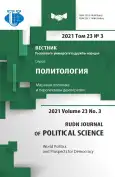Poland and Hungary: Democratic Backsliding and the Shifting European Political Landscape
- Authors: Everett J.1
-
Affiliations:
- National Research University Higher School of Economics
- Issue: Vol 23, No 3 (2021): World Politics and Prospects for Democracy
- Pages: 394-406
- Section: GEOPOLITICS AND PROSPECTS FOR DEMOCRACY
- URL: https://journal-vniispk.ru/2313-1438/article/view/322568
- DOI: https://doi.org/10.22363/2313-1438-2021-23-3-394-406
- ID: 322568
Cite item
Full Text
Abstract
This study focuses on the role of Poland and Hungary in the shifting European political landscape, especially considering their recent democratic backsliding. Methodologically, the impact of domestic factors, specifically those involved in democratic backsliding, are qualitatively considered as a source of Poland and Hungary’s international policy, focusing on European politics. There is significant literature available on the waves and counter waves of democratic change in the world, which is used to provide context for the cases at hand. Then, the theory of consolidation of democracy is considered, including whether Poland and Hungary were really cases of consolidated democracies. The developing Polish-Hungarian coalition, in the European context, is then considered. The two nations’ role in driving the EU towards a more restrictive migration policy during the migration crisis is discussed, as is the future EU role of Poland and Hungary. The article finds that whether through extreme pressure, setting the agenda or leading the way, as during the migrant crisis, or forming a new European political grouping, Poland and Hungary look set to actively attempt to mould the EU, and European politics more generally, to their liking.
About the authors
Judas Everett
National Research University Higher School of Economics
Author for correspondence.
Email: judas.everett@gmail.com
ORCID iD: 0000-0003-0794-0153
Postgraduate of the Doctoral School of Political Science
Moscow, Russian FederationReferences
- Badie, B., Berg-Schlosser, D., & Morlino, L. (Eds.). (2011). International encyclopedia of political science. SAGE Publications.
- Bakke, E., & Sitter, N. (2020). The EU’s enfants terribles: Democratic backsliding in Central Europe since 2010. Perspectives on Politics, 1-16.
- Baldwin-Edwards, M., Blitz, B.K., & Crawley, H. (2019). The politics of evidence-based policy in Europe’s ‘migration crisis.’ Taylor, Francis.
- Bermeo, N. (2016). On democratic backsliding. Journal of Democracy, 27(1), 5-19.
- Bozóki, A., & Ishiyama, J.T. (Eds.). (2002). The communist successor parties of Central and Eastern Europe. Routledge.
- Csehi, R., & Zgut, E. (2021). ‘We won’t let Brussels dictate us’: Eurosceptic populism in Hungary and Poland. European Politics and Society, 22(1), 53-68.
- Ekiert, G., & Kubik, J. (1998). Contentious Politics in New Democracies: East Germany, Hungary, Poland, and Slovakia, 1989-93. World Politics, 50(4), 547-581. JSTOR.
- Gorokhovskaia, Y. (2017). Democratic consolidation [Data set]. Oxford University Press. https://doi.org/10.1093/obo/9780199756223-0224
- Goździak, E.M., & Márton, P. (2018). Where the wild things are: Fear of Islam and the anti-refugee rhetoric in Hungary and in Poland. Central and Eastern European Migration Review, 7(2), 125-151.
- Holesch, A., & Kyriazi, A. (2020). Democratic backsliding in the European Union: The role of the Hungarian-Polish coalition. East European Politics, 1-20.
- Huntington, S.P. (1991). Democracy’s Third Wave. Journal of Democracy, 2(2), 12-34. https://doi.org/ 10.1353/jod.1991.0016
- Gunitsky, S. (2018). Democratic Waves in Historical Perspective. Perspectives on Politics, 16(3), 634-651. https://doi.org/10.1017/S1537592718001044
- Jasiecki, K. (2018). “Conservative modernization” and the rise of law and justice in Poland. In New conservatives in Russia and East Central Europe (pp. 130-153). Routledge
- Kelemen, R.D., & Pech, L. (2019). The uses and abuses of constitutional pluralism: Undermining the rule of law in the name of constitutional identity in Hungary and Poland. Cambridge Yearbook of European Legal Studies, 21, 59-74
- Lévesque, J. (1997). The enigma of 1989: The USSR and the liberation of Eastern Europe. University of California Press.
- Levitsky, S., & Ziblatt, D. (2018). How democracies die (First edition). Crown.
- Linz, J.J., & Stepan, A.C. (1996). Toward consolidated democracies. Journal of Democracy, 7(2), 14-33.
- Magyar, B., & Madlovics, B. (2020). The anatomy of post-communist regimes: A conceptual framework. Central European University Press.
- Magyar, B., & Vásárhelyi, J. (Eds.). (2017). Twenty-five sides of a post-communist Mafia state. CEU Press.
- Nyyssönen, H. (2018). The East is different, isn’t it?-Poland and Hungary in search of prestige. Journal of Contemporary European Studies, 26(3), 258-269.
- Öniş, Z., & Kutlay, M. (2020). Reverse transformation? Global shifts, the core-periphery divide and the future of the EU. Journal of Contemporary European Studies, 28(2), 197-215.
- Sata, R., & Karolewski, I.P. (2020). Caesarean politics in Hungary and Poland. East European Politics, 36(2), 206-225.
- Szawiel, T. (2009). Democratic consolidation in Poland: Support for democracy, civil society and the party system. Polish Sociological Review, 168, 483-506. JSTOR.
- Vachudova, A. (2020). Ethnopopulism and democratic backsliding in Central Europe. East European Politics, 36(3), 318-340.
- Waldner, D., & Lust, E. (2018). Unwelcome change: Coming to terms with democratic backsliding. Annual Review of Political Science, 21(1), 93-113. https://doi.org/10.1146/annurev-polisci-050517-114628
Supplementary files









